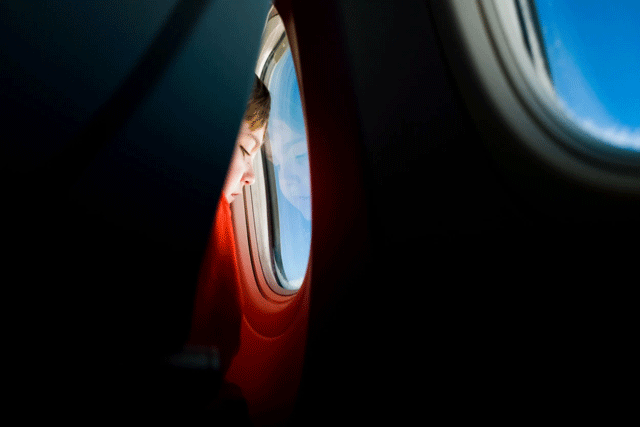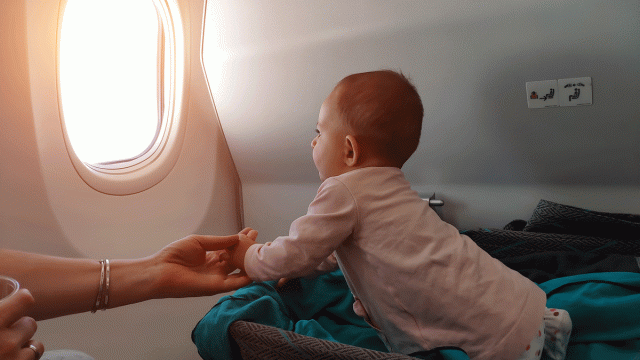Top jet lag prevention tip: try not to stress about it too much
You’ve packed. You’ve planned. You’ve crossed your fingers for no delays, cancellations, lost luggage, fevers, tantrums, accidents, earaches, or upset tummies.
But what about jet lag? Is there any way to prevent its trademark exhaustion from turning your otherwise cheerful jet-setter into a crabby, irritable mess?
“Exploring the world is fun, but having a cranky toddler dealing with jet lag isn’t,” sleep medicine physician and pediatric pulmonologist Dr. Funke Afolabi-Brown said in an article on her website, Restful Sleep MD. “Toddlers and older kids tend to have a more challenging time as they adjust to the different time zones. While these adjustments only take a few days, they could be the longest days of your and your child’s travel experience.”
So what’s a globetrotting parent to do? From what time to fly and what to bring on board to what sorts of things to schedule on the first day of your trip, here are a few expert tips for helping your kids (and you!) beat jet lag fast.
First of all: What is Jet Lag—And Why Does it Happen?

It’s not just because you didn’t sleep on the plane (though that doesn’t help). Jet lag happens when our body’s natural circadian rhythm gets mixed up by crossing multiple time zones. Basically: Your brain thinks it’s in one time zone (home); your body is in another (vacation). Not surprisingly, the more time zones you cross, the worse the jet lag.
Note: Jet lag does not occur on north-south flights that do not cross multiple time zones, according to The Sleep Foundation.
“When you travel across time zones, that internal clock is still in sync with your original time zone and out of sync with the new time zone,” Afolabi-Brown said in the article.
Symptoms of jet lag include exhaustion, brain fog irritability, headaches, and digestive upset (especially in children). And, depending on how you acclimate (and whether you follow the steps below), experts say it can take one day to adjust for every time zone crossed—though you likely won’t have all the symptoms for this long.
Does it happen for babies? Yes! According to the Pediatric Sleep Council, babies are just as likely to experience jet lag as adults, though it may be less noticeable for babies under 6 months who don’t have a regular sleep schedule.
Tips to Prevent Jet Lag—Before Your Flight

1. Stay hydrated: Dehydration can make jet lag worse, so make sure your kids drink plenty of water (or formula/breast milk/etc.) before, during, and after a long flight. Caffeinated beverages can also contribute to dehydration, so if you’ve got older kids who like Coke or other caffeinated drinks, try to encourage them to choose non-caffeinated pop instead.
“I always try to make this fun for my kids. We make Kool-Aid the day before and we make sure to drink it all,” a mom blogger wrote on Jet Lagged Mama. “Then during the trip, we always let them pick out fun drinks either at gas stations or sometimes I will pack a few fun drinks in my carry-on.”
Note for parents: While you might want to drink a glass of wine to ease your nerves before and during a flight, alcohol can also make jet lag worse—so try to say no.
2. Prep for your destined time zone: If you know your destination is a few hours behind, don’t stress when your kids aren’t asleep at 11 p.m. as it’ll actually help them! Similarly, if you’re traveling to a place where it’s later than your home time zone, try to move your kids’ bedtime earlier as you get nearer to takeoff. (This is easier said than done, we know. So don’t stress!)
Related: Top Tips to Make Air Travel with Kids A Little Easier
What You Can Do to Prevent Jet Lag—On The Plane

1. Pick your flight wisely. While some parents avoid red-eye flights (especially with younger children who may keep the whole cabin awake when they can’t sleep), many prefer to fly the night away because kids simply fall asleep better when they know it’s dark outside. Depending on when you’ll land, it’s good for your kids to sleep at least a little bit on the plane.
That said, if you know you’ll be landing at nighttime, you don’t want your kid to get a full night’s slumber on the airplane. To keep them from sleeping too much, pack games and “presents” for them to open to keep them entertained (this way they’ll be able to sleep when you get there). This is one of those times when screen time is your friend since blue light actually inhibits melatonin production and will help your kids stay awake longer.
2. Choose a flight that arrives in the daytime—and stay awake when. you get there! Getting to your destination during the day means you’re more likely to jump right into the new schedule. (Hint: Don’t take a nap when you get to your hotel!). Stay awake and relatively active when you arrive so that, by evening, your kids will be so pooped they’ll practically put themselves to bed.
“We typically take red eyes and then try to plan an activity close to when we land so it forces us to stay awake through the excitement of the activity,” said family travel Vlogger Trevi O’Neil from The Adventure Buddies. “Versus getting to your destination and then looking to sleep right away.”
Related: Must-Try Travel Hacks to Flying with Babies
3. If you have. a baby (and want them to sleep), get a bassinet seat. Sure, holding your baby while they sleep will do the trick, but if you want to catch some Zzzs yourself, it helps to have a place to put your little one. Many long-haul or international flights offer travel bassinets that clip into the wall of the bulkhead seats. The rules vary by airline, but most bassinets are only available for infants under the age of one and less than 25 pounds. For details on where your chosen airline stands, check out this comprehensive list of bassinet seats on 50+ airlines.
4. Pack these things: Even if you’ve got a like-clockwork sort of sleeper, getting kids to knock out on planes can be tough. So arm yourself with all the sleep-inducing extras you can fit in your carry-on. This could include:
- Your child’s favorite blanket, pillow, and stuffie
- Pajames (at least two sets, if you’re worried about accidents)
- A mask to block out light (if your child will keep it on)
- For babies in car seats: A cover or light blanket to block out light
- For smaller children: This inflatable cushion which allows kids to put their feet up or lay flat in the seat (if allowed by your airline).
Related: The Ultimate Guide to Flying with Babies
Tips to Prevent Jet Lag—At Your Destination

1. Follow the Light: One of the key strategies for helping kids beat jetlag is adjusting their exposure to light and dark, according to Kelly Murra, a certified pediatric and adult sleep consultant based in Los Angeles. “Light plays a crucial role in regulating our internal body clock,” Murra said. “When we travel across time zones, our body clock gets all confused, and that’s when jetlag kicks in.”
So use light to your advantage! If you arrive in the daytime, expose your child to natural light to help signal to the body that it’s daytime.”Encourage them to go outside, play in the sunlight, or simply have a stroll in a nearby park,” Murra said.
Then, when you wake up the next morning, get them some sunlight as soon as possible. For example, take a family walk, go to a playground, or push your baby around in the stroller.
“This will signal to their body that it is the new wake-up time by triggering the production of cortisol, the alert hormone, as well as program their body to produce melatonin, the sleepy hormone, earlier than it normally would,” according to Murra.
2. Limit the lights at nighttime: While getting your kids some sun helps acclimate them to daytime; when it’s nighttime in the new time zone, you want to do the opposite. Murra suggests limiting your kids’ exposure to bright lights in the evening, especially from screens like phones, tablets, or TVs. Turn off overhead lights and use lamps instead to create a softer light.
“Create a calming and dim environment, mimicking nighttime conditions,” she said. “This helps trigger the release of melatonin, a hormone that encourages sleep.
3. Stay awake! Sure, the first thing you’ll want to do when you arrive is lay down flat for a long nap. But… Resist! Afolabi-Brown advises not letting kids sleep more than two hours during the day for the first few days of your trip. Remember: You want them to be tired at nighttime. (Pssst: Same goes for you!).
“The faster you get your sleep aligned with the new time zone, the faster you will get over your jet lag,” Jet Lagged Mama blogger said in this article. “So staying awake on your first day is extremely important.”
4. Keep kids moving (until bedtime): During the first two days, try to keep things busy so that kids are revved up until bedtime. Sure, there may be a few meltdowns, but if you stick it out, you’ll kick jet lag to the curb way faster. At least, that’s according to veteran traveler Katie Dillon, a writer who has flown across oceans with her daughter since she was 6 weeks old.
“If you can sleep through the night on nights one and two after flying overseas, the remaining nights will typically be easy peasy,” Dillon said on her website, LaJollamom.com. “Be strategic about how you keep them awake, and they’ll never know what you’re up to. It’s one of the best ways to ensure they don’t get jet lag, or it may last for just a night or two versus an entire week.”
5. Keep the activities mellow in the beginning: The first day of your trip should be considered a “buffer day.” So keep things light. You want to be busy—but don’t do the big stuff that you know will take a lot out of you (and your kids). Go to the park or playground. Take a walk. Play games together outside. Remember, exposing yourself to the sun helps your body adjust faster, so whatever you do—do it outside, if possible.
“Hopefully you do not plan to climb the Eiffel Tower or tour the Colosseum on the first day of your trip,” wrote this travel blogger. “Take the kids walking around the neighborhood, to a local park or square, something relaxing and low key. They need to be out in the sun exercising, and the more time you can spend outdoors in the bright light, the easier the adjustment to the new time zone will be for everyone.”
6. Eat like a local: Afolabi-Brown suggests adjusting your child’s meal times to the new destination as soon as you arrive. If your kids are begging for food outside of these times (like when you’re struggling to sleep at 2 a.m.), you can give them a small snack, but try to hold out until they can have a proper meal at the right time.
7. Exercise: According to research published In The Journal of Physiology, exercising at certain times of the day can potentially help treat jet lag. According to the study, exercising between 1 and 4 p.m. can potentially shift your circadian rhythm to an earlier schedule, which could help get your internal clock back to its happy place. So get your kids out and play!
8. Make Your Child’s “Vacation Room” Feel Like Home: Sleeping in a bed far, far away can be scary for kids. To make things feel more familiar, bring things from home that your child already associates with sleep. If you use a certain sound machine or night light, for instance (we love this Sleep Sheep and this Tranquil Whale music and light projector), bring those with you to make home-away-from-home feel just as cozy.
9. Try melatonin: While you should always check with your pediatrician before giving your child melatonin, it can help kids adjust to a drastically different sleep schedule, Afolabi-Brown said. It also helps to get kids (and their parents) back to sleep when they wake up in the middle of the night.
Don’t use adult-dose melatonin for kids. Try brands marketed for children containing 1 mg or less of melatonin as approved by your pediatrician.
What You Can Do to Prevent Jet Lag—When You Return

It’s inevitable: Just when you and your fam are finally feeling A-OK—You have energy! The kids are doing great! Vacation life is perfect!— It’ll be time to come home.
Cue the jet lag once again! But this time, you know the drill: Spend your days in the sun; keep things dim in the evening. Hydrate. Eat meals on time. Don’t nap. Sure, it’s a process, but if you follow these steps, you’ll be back to normal in a few days.
Depending on which way you’re flying, you may find jet lag easier or harder the second time around. Flying West? You may have an easier time, according to The Sleep Foundation, it’s easier to delay your internal clock than advance it.
“Like everything that comes with parenting, each child is different. Each situation is different,” Tavia Carlson wrote on her blog, Big Brave Nomad. “The best way to overcome jet lag is to take it one day at a time. It is temporary.”
And it’s worth it! Despite the sleep snafus, foggy mornings, and cranky moments, traveling not only brings families closer, but studies show it also makes kids smarter and more empathetic humans.
So bring on the jet lag!
Related: 7 Reasons to Travel with Your Kids











